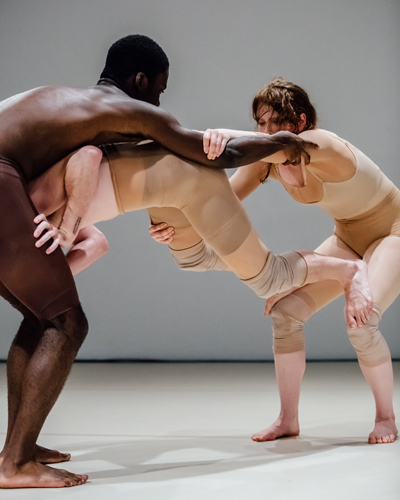Dance: (C)Arbon: A Dance Installation at the Met Breur
By Dawn Lille
arttimesjournal June 21, 2018
This past season the Metropolitan Museum invited Andrea Miller to be its first choreographic Artist in Residence. For their end of year performance her company, Gallim, presented (C)Arbon at the Met Breuer, a work made alongside the exhibit Like Life: Sculpture, Color and the Body (1300 – Now). This was in conjunction with Met Live Arts, which presents contemporary performance in relation to the museum’s exhibits and gallery spaces.
It seems de rigueur these days that every museum present some sort of performance or performance art. This is not new given the coming together of dance and art in the galleries of the 60’s and the Whitney’s early space dedicated to dance. Even before that MOMA and the Brooklyn Museum had connected with this art form. When, a few yeas ago, the Whitney awarded first prize to a choreographer at the biennial, it was official.
Miller, a young choreographer, was trained in Humphrey/Weidman technique before she attended Juilliard. After graduation she spent time in Israel with the Batsheva Ensemble, returned to New York, and formed Gallim in 2007.
Her work, which has been seen internationally and on other companies, is usually characterized by strong, visceral movements that demand much from the bodies carrying out its powerful and seemingly impossible demands. In the past, Miller’s choreography has shown a lack of fear and occasional borrowing from other choreographers, as well as the maturation of a young creator. Sometimes it has also shown a desire to cover up vulnerability with its daring demands on the human body.
The Breuer exhibit presented figurative sculptures of the human body. Looking closely and intently at the 150 international examples, it was possible to gain an understanding of the different attitudes toward the body, not to mention the often repeated sense of what was hidden.
 |
Miller’s movement approach to the exhibit reflects her concept of what she terms the “anthropology” of the human body, which “contains and retains individual and collective experiences … beyond the arrangement of anatomical parts.” In other words, how much history our bodies contain. (C)Arbon, the final result, was created in collaboration with her dancers, as well as the filmmaker Ben Stamper and the composer Will Epstein.
The piece took over the fifth floor of the Breuer. Attendees at the museum were invited to attend nine days of open rehearsals and six of the final work (performed three times a day) as part of their museum entrance fee. The performance took place in three rooms simultaneously and featured a loop of a solo, a duet and a trio/group, each of which lasted thirty minutes and was performed a total of three times, with the dancers changing each time.
Thus one could move from room to room and witness the entire ninety minute work or stay in one room and see the same section performed by three different casts. If they chose to remain most of the day they could change to a different room for each performance, viewing the installation from every possible angle.
The solo was performed in front of an incline, up which the dancer eventually climbed and crawled, to balance briefly on top and then drop behind. Beginning on the floor with the body arched and then flattened in contortionist-like movements, it suggested an amoeba that gradually, via non - human extremes in the body, developed into something that could ascend the elevation. The concentration needed and provided by the dancer I saw, Allysen Hooks, was phenomenal.
The duet was performed in a smallish room with a large, square, elevated platform in the middle, reminiscent of a boxing ring. And the two performers, a male and a female, wore red boxing shorts. At first they were, indeed, adversaries, their two clinging bodies almost destroying each other. There was a kiss that was violent and robotic movements that evolved into loose, free phrases suggestive of African dance. This became an interrelationship – a mating ritual perhaps?
 |
The trio, which evolved into a group dance, took place in the large central room and made use of the wall, to which the dancer clung and clutched each other like those who had reached the end of a fearful journey. Or were they catatonic patients in a mental ward? Sometimes the expanded group fleetingly resembled classic Greek statues, but other times tense crouches, tumbles, rolls and balances prone to falls suggested vulnerability.
One section of sustained unison walks and movements, plus a cumulative rhythmic part suggestive of the choreographer Trisha Brown, implied peaceful development or advancement. Legs often moved outward from the hip joint as though they were separate entities; sometimes the leg appeared to lift from the mid-thigh. Four couples performed simultaneously, but as though they existed in separate worlds.
Stamper’s film visuals, that often featured extreme close ups of different body parts, as well as what looked like a churning sea, flat stones on a cracked, dry surface and sheets of graph paper suggesting space, existed alongside the movement, but often did not connect with it. One section, in which the dancer’s shadows were seen against the moving images was effective. The soundscape, which varied from strong rolling waves to drums and a variety of bells, sometimes supported the movement and others was pleasant background.
(C)Arbon, an exploration of the body as a singular element, in relation to another and in a social group, brought dance to an expanded audience and led many to relate it to the museum exhibit Like Life.
dawnlille@aol.com
